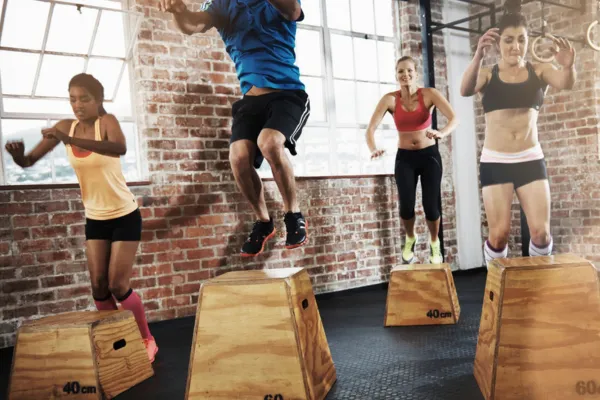
Read Our Blogs

Power Up Your Spikes: Plyometrics for Volleyball
Volleyball is a sport of dynamic movements, explosive jumps, and powerful spikes. To excel in this demanding game, you need more than just strength and agility; you need power. Plyometrics, also known as "jump training," are exercises designed to develop this explosive power, transforming you into a force to be reckoned with on the volleyball court.
Plyometrics involve rapid, powerful movements that train your muscles to exert maximum force in short bursts. This type of training enhances your ability to jump higher, spike harder, and move with explosive speed and agility, giving you a distinct advantage in volleyball.
Why Plyometrics Matter: Fueling Your Volleyball Explosiveness
Plyometrics are not just a supplementary training method; they are a cornerstone of volleyball conditioning, offering a range of benefits that directly translate to improved performance on the court.
Increased Vertical Jump: Reach New Heights
Jumping is a fundamental skill in volleyball, whether it's for spiking, blocking, or reaching for a dig. Plyometric exercises train your muscles to generate force quickly and efficiently, leading to a higher vertical jump.
By incorporating exercises like box jumps, jump squats, and tuck jumps, you can develop the explosive leg power needed to elevate your game, literally. This translates to more powerful spikes, more intimidating blocks, and a greater ability to reach those seemingly impossible balls.
Enhanced Spiking Power: Unleash Devastating Spikes
A powerful spike can be a game-changer in volleyball, capable of breaking through the opponent's defense and securing crucial points. Plyometrics develop the explosive power needed to deliver those devastating spikes.
Plyometric exercises like depth jumps and single-leg hops train your muscles to generate maximum force in a short amount of time, translating to more powerful arm swings and a greater ability to transfer that power to the ball.
Improved Agility and Speed: Dominate the Court
Volleyball is a fast-paced game that requires quick movements and rapid changes in direction. Plyometrics enhance your agility and speed, allowing you to cover the court effectively and react quickly to the ball.
By incorporating exercises that involve quick changes in direction, such as cone drills and shuttle runs, you can improve your footwork, reaction time, and overall agility, making you a more versatile and effective player.
Stronger Bones and Muscles: Build a Resilient Body
Plyometrics not only enhance your explosive power but also strengthen your bones and muscles, reducing the risk of injuries common in volleyball.
The impact forces generated during plyometric exercises stimulate bone growth and density, making your bones stronger and more resistant to fractures. This is particularly important for volleyball players who are prone to stress fractures and other overuse injuries.
Plyometrics also strengthen the muscles and connective tissues around your joints, providing greater stability and support, which can help prevent sprains, strains, and other common volleyball injuries.
Plyometric Exercises for Volleyball Players: A Powerful Arsenal
Plyometric exercises come in various forms, each targeting different aspects of explosive power and agility. Here are some effective plyometric exercises for volleyball players:
Box Jumps: Jumping onto a box of varying heights is a classic plyometric exercise that develops explosive leg power. Start with a lower box and gradually increase the height as your strength and confidence improve.
Jump Squats: Jump squats combine the benefits of squats with explosive jumping, targeting both strength and power. Perform a regular squat and then explode upwards into a jump, landing softly and repeating the movement.
Tuck Jumps: Tuck jumps focus on developing explosive power in the lower body while also challenging your core stability and coordination. Jump upwards and bring your knees towards your chest, landing softly and repeating the movement.
Depth Jumps: Depth jumps maximize explosive power by utilizing the stretch-shortening cycle of your muscles. Step off a box and immediately jump upwards upon landing, focusing on maximizing the height of your jump.
Single-Leg Hops: Single-leg hops improve single-leg power, balance, and coordination, which are crucial for volleyball movements like spiking and blocking. Hop on one leg, focusing on maintaining balance and generating power with each hop.
Integrating Plyometrics into Your Training: A Gradual Approach
Plyometrics are high-impact exercises, so it's important to incorporate them gradually into your training routine, especially if you're new to this type of training.
Proper Form: Focus on proper form and technique to maximize the benefits and prevent injuries. Land softly and control your movements to avoid excessive stress on your joints.
Progression: Start with simpler exercises and gradually progress to more complex ones as your strength and power improve. Don't push yourself too hard too soon.
Warm-up: Always warm up thoroughly before plyometric training to prepare your muscles and joints for the explosive movements.
Listen to Your Body: Pay attention to your body and avoid overtraining. If you're feeling pain or fatigue, take a break or modify the exercises.
Variety: Incorporate a variety of plyometric exercises to target different muscle groups and movement patterns. This helps prevent boredom and ensures balanced development.
Consistency: Make plyometric training a regular part of your routine to see consistent improvement in your explosive power and agility.
Plyometrics: A Foundation for Athletic Performance
Plyometrics are not just for volleyball players; they are a valuable training tool for athletes in various sports and activities that require explosive power and speed. Whether you're a basketball player, a sprinter, or a martial artist, plyometrics can help you enhance your performance and reach your athletic potential.
Here are some additional tips for incorporating plyometrics into your training:
Incorporate plyometrics into your warm-up: Add a few plyometric exercises to your warm-up routine to activate your muscles and prepare your body for more intense activity.
Combine plyometrics with strength training: Integrate plyometric exercises with your strength training routine to maximize your power and explosiveness.
Use plyometrics for interval training: Incorporate plyometric exercises into your interval training workouts to add variety and challenge your cardiovascular system.
Make it fun: Find ways to make plyometric training enjoyable, such as incorporating music or playing games with friends.
By incorporating plyometrics into your training, you'll develop the explosive power, speed, and agility needed to dominate the volleyball court. Plyometrics are not just about jumping higher or hitting harder; they are about unlocking your full athletic potential and becoming a more dynamic and powerful athlete.
Reserve your Volley Pro now and unleash your spiking power!

Reliable, professional pressure washing services for pristine results.
Copyright Volley Pro 2025. All rights reserved
